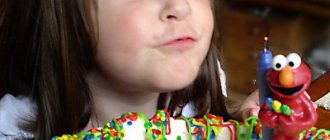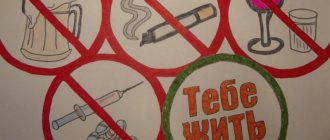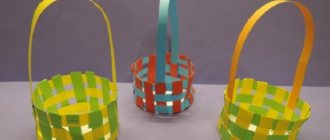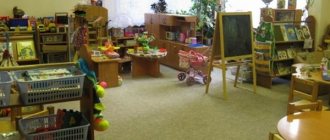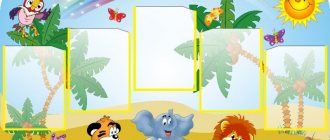What is it for?
Raising a patriot cannot be successful without referring to the culture and history of one’s region. Today, much of the life of our ancestors has been lost and forgotten, the way of life of the people has changed greatly, and we turn so little to our roots, but the unique culture of the Russian people has been formed over centuries and is full of various customs, traditions and rituals.
Knowledge and understanding of folk culture, the desire to join its further development in the future will become motives for active creative activity of a person if patriotic education begins from early childhood.
Decorating a patriotic corner in a kindergarten with your own hands will help teachers and parents organically introduce the child to the world around him, introduce him to his native culture, the eternal and the beautiful.
How to design a patriotic education corner in kindergarten
Patriotic education is an important component of the formation of a future personality. From birth, a child is not given a feeling of love for his homeland, respect for family and folk traditions, pride in his people and state. All these qualities are nurtured by family and society starting from kindergarten. Whether pupils will become patriots of their Fatherland, whether young men and women will want to defend the interests of the state if necessary - this largely depends on the formation of their worldview at a very early age.
Where to start?
It is still difficult for kids who have just arrived in kindergarten to think in terms of a city, country, or culture. For them, the homeland is their immediate environment, so information about home and family that is accessible to children of this age should be contained in a patriotic corner in the kindergarten. The design of the 1st junior group requires a simple but bright design. It is important to attract children's attention and arouse their interest. At this age, speech is actively being formed, so everything should contribute to development, encourage the baby to recognize and name. Children can first simply observe the activities of adults who look at albums, naming all family members in the photos. Gradually, imitating adults, they themselves will begin to do this.
visual aid “A Corner of the Native Land”
| Author: Pomaskina Natalia Alexandrovna, teacher MADOU "Combined kindergarten No. 46" Tobolsk. |
visual aid “Native Corner” (a corner for observing changes in nature)
Brief summary:
Age category: 3-7 years.
Goal : to systematize children’s knowledge about the nature of their native land at different times of the year.
Tasks :
— to form ideas about seasonal changes in nature, about the seasons;
- develop curiosity and observation, the ability to see the beauty and uniqueness of nature at different times of the year;
— consolidate knowledge about trees, birds and animals of their native land;
- expand your vocabulary, develop coherent speech when composing descriptive stories about the weather, the time of year;
- develop visual arts skills, fine motor skills, fantasy and imagination when decorating a corner, making sketches about changes in nature;
- cultivate love for the native land.
Working method:
There are various calendars and albums for sketching daily weather observations. The children and I created a corner of our native nature in the group, where we note various seasonal changes in nature. This form of work develops in children knowledge about the gradual, consistent change of foliage on trees, its rate of fall, the arrival and life of birds in the forest.
For example: in the fall, children found beautiful golden birch branches and placed them in a corner, after a while - a branch of bright variegated rowan, then aspen, bird cherry, oak, and maple appeared. The children admired the corner they had created with their own hands. Notice that the oak remains green. Then, also gradually, the children noted from which tree the leaves began to fall off, and observed leaf fall not only on the street, but also in the corner of the group. The children found out that every tree has seeds. They made puddles out of paper, glued leaves to them with tape, and they got frozen leaves in puddles. Gradually, the children sprinkled the entire corner with snow (cotton wool), and it turned out to be late autumn.
In winter, we made birds (tits, bullfinches) and placed them on a rowan tree (there were no leaves, but the berries remained). In our corner, we noted all the changes that the children talked about (footprints, ski tracks).
Spring came (change of pictures), the snow melted (the cotton wool was removed), the children found and brought a blossoming willow twig to the corner, drew streams, dark paths, cut out puddles, rooks.
With the changes in the nature of our native land in the spring, interesting work continues in our corner. Spring dragged on this year, snow fell again and it also appeared in our corner. What will our calendar look like in the summer? Children will decide this based on their observations about the weather.
Daily work with this visual aid develops in children an interest in nature, a desire to notice something unusual in nature and tell friends in the group about it, and make changes to our calendar themselves. In addition, this manual can be used to form mathematical concepts, to develop coherent speech, to develop artistic creativity skills, because everyone wants to create their own small album of observations of the nature of their native land.
1 vote was given for this work.
Voting ended on April 13, 2014 at 11:00 p.m. Thanks everyone for participating!
Share
How to fill the patriotic corner in the nursery group?
This can be any material on social and moral development:
- Thematic folders containing illustrations with images of family members demonstrating their relationships, care, and joint affairs.
- Photo album “My Family” with images of pupils in a family environment.
- An album or exhibition “Here we live”, in which you can place photographs, illustrations or models of streets or various architectural buildings (kindergarten, school, houses where children live, other city objects).
- Exhibitions introducing the origins of Russian folk culture, which may contain a variety of antiquities, traditional toys (wooden and rag dolls), amulets, exhibits of decorative and applied art (painted nesting dolls, trays and other utensils with Gorodets, Khokhloma and Gzhel painting, Dymkovo toys , embroidered towels, scarves, knitted napkins, tablecloths and other items).
Fiction, works of folklore - songs, jokes, nursery rhymes and fairy tales - can also be placed in a patriotic corner in a kindergarten. The design of the nursery is meant to be colorful and understandable; it should not contain a lot of text; it is better if it is visual material that attracts the attention of children and their parents. It is important to remember the safety requirements, which are the same for all corners: all materials must be placed so that they cannot fall or injure the child. No sharp corners or edges are allowed.
Older children - tasks are more difficult
More complex concepts become accessible to the understanding of four-year-old children, therefore, complementing and developing the topics covered in younger groups, teachers and parents continue the direction of education we are considering, placing new materials in the patriotic corner in kindergarten. The design should influence the development of the child’s personality. It is important that not only literature, illustrations and teaching materials are used, but also elements of independent and joint activities. Preschoolers can play with friends or with adults, mastering the posted materials and making interactive connections.
The design of a patriotic corner in a kindergarten in the middle group should be beautiful, bright, attractive and interesting for children. There can be nothing damaged, broken or torn here. It’s good if the colors and shades used are correctly combined with each other and are pleasing to the child’s eye. All materials are updated from time to time.
In the middle group, most of the patriotic work takes place in and outside of class. These include purposeful walks along nearby streets and getting to know the administrative buildings located on them (shop, pharmacy, post office, etc.), reading fiction, talking with children about the nature of their hometown. All new information that children receive should be supported by materials in the patriotic corner.
Work in the patriotic corner of the kindergarten
In addition to posting information on corner stands designed for independent activities of preschoolers, patriotic work can include short messages, conversations, reading stories and poems using the materials presented. Activities related to this area of the educational process are being carried out.
Examples of organizing patriotic education:
Examples of event notes on patriotic themes
Summary of an open event on the patriotic education of children in the preparatory group on the theme “My Motherland.”
Contents for the middle group
Children of this age will find the following materials interesting and useful for their development:
- illustrations of family holidays and traditions, fiction on moral themes;
- photographic materials, illustrations, albums, postcards, thematic folders introducing the history of the native city, its famous residents, and attractions;
- exhibits that introduce preschoolers to traditional culture: antique objects, folk toys, examples of decorative and applied arts, themed didactic games;
- works of folk art - from songs to fairy tales;
- symbols of the state, region and city.
What do we call home?
In older preschool age, the tasks of patriotic education become more complicated, children continue to get acquainted with their native land, study not only their city, but also the region and the country, receive information about state symbols, the historical past of Russia, and the national calendar.
The material placed in the patriotic corner in kindergarten also becomes more complex. The decoration is complemented by children's and family creative works. For example, while continuing to study the topic “My Family,” children and their parents create a family coat of arms or family tree. Family albums placed in the corner, which children love to look at and show to each other, will also be interesting.
Goals of creating and operating a patriotic corner in kindergarten
Patriotic education of preschool children is an obligatory component of the activities of preschool teachers. It consists not only in nurturing love for our common Motherland Russia, but also in teaching a caring attitude towards those closest to you: family, home, the place where you were born, the nature that surrounds you. Currently, due to changes in society, patriotism is the anchor on which the concept of “state” rests. And the formation of this quality in the new generation plays such an important role.
More information about organizing classes on patriotic education can be found in our article - How to conduct a class on patriotic education in kindergarten.
Like any educational influence on a child, the formation of patriotic feelings uses visual methods, verbal methods and others. Creating a well-designed patriotic corner will help the teacher in solving this complex, multi-component task.
What rules should be followed when organizing a patriotic corner?
Like any other component of the subject-developmental environment of a kindergarten, the patriotic corner must comply with the requirements of the Federal State Educational Standard:
The passport of the patriotic corner, as part of the group’s passport, can be seen in the example.
In what areas is the information base being prepared for the patriotic corner?
Table: features of the selection of material depending on the age of the children
From hometown to country
Various materials on the following topics will help you continue your acquaintance with your hometown: “How did the city arise?”, “What is produced in our city?”, “The culture of my city,” “Famous fellow countrymen,” “During the Great Patriotic War,” “Sights” , "Architecture". Parents and educators can jointly create a selection of poems about the city.
The map of the locality and its symbols should also replenish the patriotic corner in the kindergarten. The design of an exhibition about the native land may contain symbols and a map of the region, information about its cities and famous places, and when children perceive this information, they will be ready to get to know their native country. Here you can’t do without a map of Russia. Modern printing produces special children's cards containing material accessible to children's understanding. And, of course, Russian symbols should appear in a prominent place - the coat of arms, flag, anthem and portrait of the president.
About culture, defenders of the Fatherland and planet Earth
In addition to local history information, other topics and areas contribute to patriotic education.
If the necessary material is available, information about how the culture of our people was born is posted in the patriotic corner. These could be thematic exhibitions “How did people live in Rus'?”, “What do ancient things tell about?”, “From the history of Russian folk costume”, “How did people walk and have fun?”, “Folk calendar” and others.
Information about the defenders of the Fatherland can also replenish the patriotic corner in kindergarten. The design (photo below) of exhibitions about the heroes of the Russian land, the Great Patriotic War and the Russian Army can arouse the interest of boys and instill in them a desire to become a defender of their homeland.
The global task of patriotic education is to form in children the concept that planet Earth is our common home, and everyone who lives on it should live in peace. Children need to be introduced to the living conditions of people in other parts of the planet, their customs and traditions.
If teachers and parents are interested in educating a young citizen, then the result will not be long in coming, and the corner of patriotic education will help in this.
Local history corner in the developing subject-spatial environment of the group
Modern teachers believe that the basic stage of developing love for the Motherland in children should be considered their accumulation of social experience of life in their village, assimilation of the norms of behavior and relationships accepted in it, and introduction to the world of its culture. Love for the Fatherland begins with love for one’s small Motherland - the place where a person was born.
Psychological and pedagogical research has shown that local history classes are available to preschool children.
What is local history? Local history is the study of a certain part of the country, city, village or other settlements by the local population, for whom this territory is considered their native land. “Edge” is a conditional concept and depends on who is studying it and for what purpose. This could be a city, a district, or a street, that is, what surrounds us.
One of the important conditions in the work on local history is the creation of a developing subject-spatial environment in the group.
When designing and selecting materials to create a local history corner in our group, we adhered to the following rules:
— the material must be understandable and accessible to the age of children;
— the materials must be sufficiently bright and saturated;
- provide children with the opportunity to participate in creating a corner.
The corner is located in an accessible and safe place. Children can take materials, games, and objects from the man-made world. Also, the corner can be transformed into a mini-museum, workshop, or exhibition of children's creativity. The presence of multifunctional objects, including natural materials, for use in various types of children's activities, including as substitute objects.
An important condition for success in this work is close communication with parents (legal representatives). We took part in collecting local history and educational material to replenish the local history corner: family photos, a laptop, information about Irgiz, the village, the “Love and Know Your Land” stand, design of the exhibition “Unofficial Symbols of Russia.
The information in the corner is presented in sections:
- “My family”: family photos, family tree, lapbook, children’s drawings, poems, statements about family, educational games.
- “Kindergarten”: group plan, photos of kindergarten staff, poems, we are working on creating an album “Our everyday life and holidays.”
- “Native Village”: album “Our Land”, photos of attractions, photos of famous people of the village, magazines, coat of arms of the village, information about the Irgiz River, about the village, visual illustrated and reference material “Animals and Plants of the Native Land”, game “Fifth Odd” , children's drawings.
- “The City of Samara”: map, symbols, photos of attractions, a set of postcards.
- “Country Russia”: map, symbols of the country, photo of the president, didactic game “My Russia”, illustrated and reference material.
- “Our Army”: didactic material, albums for viewing, awards of the Great Patriotic War, folder “May 9”.
- “Russian National Culture”: mini-museum of applied art - products of folk craftsmen: matryoshka, whistles, Kargopol, Fillimonov, Dymkovo toys, Zhostovo tray, Vologda lace, birch bark products, Khokhloma spoons, model “Russian hut” rag dolls, visually illustrated material: “Folk traditions and holidays”, “Russian costume”, “Folk paintings”.
The tasks of moral and patriotic education are implemented not only through the content of the local history corner , but also through the content of other areas of independent children's activity:
— samples of decorative and applied arts are presented in the children's creativity center;
— in the center of the game there are thematic sets for role-playing games: “Barbershop”, “Hospital”, “Shop”, “Farm”. These games help enrich children's ideas about professions.
— in the corner of cognitive development there are games, lotto “Professions”, a floor folder, poems;
— Russian folk tales, epics, and small folklore forms (rhymes, riddles, poems) are placed in the literary center.
Thus, not only the local history corner, but also the entire subject-development environment of the group is aimed at solving the problems of moral and patriotic education of preschool children.

